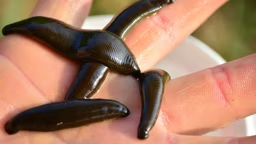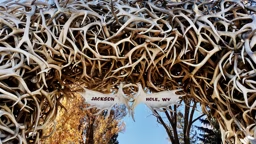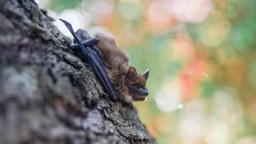In my mind’s eye, I see big, white, summer clouds rising on warm thermals through bluebird skies. Sunlight reflects from deep green oak leaves, while a hot wind blows through the bluestem grass. Above me, a lone male red-tailed hawk soars on the thermal, calling out in defense of its nest and territory with a long, hoarse, “keeerrrrrrrrrr!” In a moment, his mate joins him. She is nearly 30 percent larger than him, a common rule among birds of prey, and her wingspan is impressive at just over four feet. The paired birds soar in graceful circles, effortlessly gaining altitude.
Then I move from my mind’s eye to my actual ones and find I am still looking at a red-tail – but it’s perched, not flying. It is winter. Big, wet, wintry snowflakes are getting under my collar. It would seem the big raptor is having a similar experience. Perched on a wet branch, waiting in watch for prey, it shakes and ruffles out its feathers. I shiver in reply.
No Two Alike
As variable and individual as their admiring humans, no two red-tailed hawks look completely alike, causing moments of confusion and joy for even the most experienced birder. As geography changes, red-tails also change, and there are a number of color phases ranging from a very dark Harlan’s hawk to a very pale Krider’s red-tail.
Each bird seems to have a different variety of streaks and dark, pointed spots on what is often a white belly. Immature birds do not have a red tail, and their eyes are light, often straw-colored. Mature birds usually have a bold and rusty red tail, often tipped with thin lines of black and white, and deep brown eyes.
Adaptable & Opportunistic
Adaptable birds, red-tailed hawks are the generalists and opportunists of the raptor world. The most common of all buteos (soaring hawks), they are found throughout the North American continent, from Alaska and northern Canada through Mexico and the Caribbean, and from the Atlantic to the Pacific Coast. An impressive set of talons, larger and sturdier than those of other hawks, equips the red-tailed hawk to eat rabbits and pheasants as well as voles and mice.
Champions of hot or cold, dry or rainy climates, red-tails usually nest on the tallest structures around, whether an oak in a cow pasture or a saguaro cactus in the Sonoran desert. Soaring above wide-open tall grasses in search of prey is the most common hunting strategy, and a red-tailed hawk often abruptly terminates the soaring, dropping like a brick from the sky, talons open, to catch unwitting prey. Despite their affinity for open spaces, I have also observed red-tails hunting deep within forests, working more open, old-growth oak in search of squirrels.
Designed to Soar
Soaring birds of prey – red-tails included – take advantage of energy conservation when hunting. When temperatures are right and warm air starts rising, hawks flap into position, catch a thermal and float nearly effortlessly with outstretched wings, banking and turning to maintain lift without flapping. As they travel about, they are treated to a free ride and a front row seat in observing the lives of their unsuspecting prey below.
In mastering the art of soaring, hawks employ more than just a big wing surface. Smaller bristle feathers send messages to nerve-tissue clusters, communicating detailed information to the hawk about the position of major flight feathers, which allows the hawk to make fine adjustments. The adjustments are so precise that a hawk may nearly lock its position in the sky, moving a feather here or there, keeping its gaze on target in the moments before diving to a meal below.
Hawkeye Indeed
There is little myth surrounding the eyesight of a hawk – red-tailed hawks are truly gifted in their ability to spot small and camouflaged prey from a great distance. Because their eyes are so well adapted for viewing the distant world up close, soaring hawks often resort to an abrupt change of perspective when attempting to see something nearby. Watch hawks long enough, and you will eventually see one turn its head completely upside down to try to look at a nearby object!
Whether perched and fluffed against the rain and snow or soaring freely on a perfect prairie day, red-tailed hawks are easily spotted hunting and making their living. Add a pair of binoculars to the equation, and you will soon be sharing in the lives of these fascinating birds.
Brian M. Collins was first inspired by the red-tail’s mastery of flight as a kid growing up along the Mississippi River bluffs. After all these years, he is still discovering surprises from this common bird.
Then I move from my mind’s eye to my actual ones and find I am still looking at a red-tail – but it’s perched, not flying. It is winter. Big, wet, wintry snowflakes are getting under my collar. It would seem the big raptor is having a similar experience. Perched on a wet branch, waiting in watch for prey, it shakes and ruffles out its feathers. I shiver in reply.
No Two Alike
As variable and individual as their admiring humans, no two red-tailed hawks look completely alike, causing moments of confusion and joy for even the most experienced birder. As geography changes, red-tails also change, and there are a number of color phases ranging from a very dark Harlan’s hawk to a very pale Krider’s red-tail.
Each bird seems to have a different variety of streaks and dark, pointed spots on what is often a white belly. Immature birds do not have a red tail, and their eyes are light, often straw-colored. Mature birds usually have a bold and rusty red tail, often tipped with thin lines of black and white, and deep brown eyes.
Adaptable & Opportunistic
Adaptable birds, red-tailed hawks are the generalists and opportunists of the raptor world. The most common of all buteos (soaring hawks), they are found throughout the North American continent, from Alaska and northern Canada through Mexico and the Caribbean, and from the Atlantic to the Pacific Coast. An impressive set of talons, larger and sturdier than those of other hawks, equips the red-tailed hawk to eat rabbits and pheasants as well as voles and mice.
Champions of hot or cold, dry or rainy climates, red-tails usually nest on the tallest structures around, whether an oak in a cow pasture or a saguaro cactus in the Sonoran desert. Soaring above wide-open tall grasses in search of prey is the most common hunting strategy, and a red-tailed hawk often abruptly terminates the soaring, dropping like a brick from the sky, talons open, to catch unwitting prey. Despite their affinity for open spaces, I have also observed red-tails hunting deep within forests, working more open, old-growth oak in search of squirrels.
Designed to Soar
Soaring birds of prey – red-tails included – take advantage of energy conservation when hunting. When temperatures are right and warm air starts rising, hawks flap into position, catch a thermal and float nearly effortlessly with outstretched wings, banking and turning to maintain lift without flapping. As they travel about, they are treated to a free ride and a front row seat in observing the lives of their unsuspecting prey below.
In mastering the art of soaring, hawks employ more than just a big wing surface. Smaller bristle feathers send messages to nerve-tissue clusters, communicating detailed information to the hawk about the position of major flight feathers, which allows the hawk to make fine adjustments. The adjustments are so precise that a hawk may nearly lock its position in the sky, moving a feather here or there, keeping its gaze on target in the moments before diving to a meal below.
Hawkeye Indeed
There is little myth surrounding the eyesight of a hawk – red-tailed hawks are truly gifted in their ability to spot small and camouflaged prey from a great distance. Because their eyes are so well adapted for viewing the distant world up close, soaring hawks often resort to an abrupt change of perspective when attempting to see something nearby. Watch hawks long enough, and you will eventually see one turn its head completely upside down to try to look at a nearby object!
Whether perched and fluffed against the rain and snow or soaring freely on a perfect prairie day, red-tailed hawks are easily spotted hunting and making their living. Add a pair of binoculars to the equation, and you will soon be sharing in the lives of these fascinating birds.
Brian M. Collins was first inspired by the red-tail’s mastery of flight as a kid growing up along the Mississippi River bluffs. After all these years, he is still discovering surprises from this common bird.
Fast Facts...
Latin Name: Buteo jamaicensis
Maximum Age: Typically 40 mph, but can reach 120 mph, according to estimates.
Diet: Diverse carnivore; everything from rabbits and gophers to snakes and bats.
Maximum Age: 29 years (in captivity). Average age in the wild is around 15 years. 75 percent of young in the wild don’t live past 1 year.
Weight: Males average 2 pounds, females average 3 pounds.
Latin Name: Buteo jamaicensis
Maximum Age: Typically 40 mph, but can reach 120 mph, according to estimates.
Diet: Diverse carnivore; everything from rabbits and gophers to snakes and bats.
Maximum Age: 29 years (in captivity). Average age in the wild is around 15 years. 75 percent of young in the wild don’t live past 1 year.
Weight: Males average 2 pounds, females average 3 pounds.
Aerial Affection ...
Male red-tailed hawks (and some of their close relatives) engage in elegant, agile and powerful flight displays that, when done correctly, impress a female hawk. Often, the male seeks to impress upon his mate the agility and skill set that will bring food to the nest. Folding his wings into a bullet-like configuration, the male hawk dives very steeply, gaining a breathtaking head of speed. As he bolts past the female and approaches the ground, he exchanges airspeed for altitude. Wings tucked, he vaults steeply skyward again. Like a teenage boy on a skateboard, he will repeat the maneuver, perhaps until he feels she has taken notice. Sometimes this aerial display ends with the male touching the female with his talons, and on occasion the two will grasp talons and tumble down, down, down – separating just above the treetops.

 Brian M. Collins
Brian M. Collins  Brian M. Collins
Brian M. Collins 










